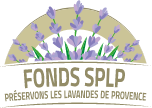Our actions
GREEN & LAVANDES
The aim of the GREEN & LAVANDES program is to improve the environmental impact of lavender and lavandin throughout their entire life cycle, right up to the production of essential oil.
Target for 2030: reduce greenhouse gas emissions and fossil fuel consumption in the lavender and lavandin sectors by 50%.
Our actions focus on 3 areas:

The program’s main actions:
- Cultivation techniques (plant cover crops, agroforestry, farmer training, etc.)
- Distillation (development of a new technology named “ecovaporator” to reduce energy consumption)
- Harvesting (development of a 3-row “Espieur” harvester to reduce the volumes transported and distilled by harvesting only the flowers)
Find out more:

ANTIGONE
Starting in 2023, the ANTIGONE (AssessiNg volaTIle orGanic cOmpouNd from lavEnders) program is an ambitious research project, which is the subject of a PhD at the Institut de Chimie de Nice.
Goals:
– improve knowledge of volatile organic compound emissions from lavender plants
– provide robust scientific arguments in a demanding regulatory context.

CECILAV
Supporting lavender cecidomyia research
Background
Lavandin cecidomyia (Resselialla lavandulae) is a midge-like insect that cycles on lavandin. Following the withdrawal of a phytosanitary product, midge damage exploded in 2021, and increased exponentially in 2022 and 2023. This damage is cumulative from year to year, leading to early grubbing-up (reducing the lifespan of the crop by 1 to 3 years), and can result in yield losses ranging from 15% to 60% per year.
General goal
Improve knowledge of the cecidomyia throughout its life cycle in order to identify alternative and effective control solutions for farmers.

Research projects conducted by ITEIPMAI and CRIEPPAM
- The first project, called AT CECIDO was an initial phase of collective reflection that began in 2023 and lasted one year. It enabled us to study the various possible avenues of research and experimentation. This project includes :
- a study of French and international scientific literature on the midge problem
- producer surveys, to obtain the most informed feedback possible,
- the organization of a symposium on May 14, 2024, dedicated to midges, to identify new avenues of work,
- the creation of a “committee of experts” to analyze the feasibility and constraints of each proposed line of work with a view to controlling this pest
- The second project, called CECILAV, focuses on 5 areas of work and began in October 2024 for a period of 3.5 years:
-
- Action 1: Study of cecidomyia biology
- Action 2: Role of varietal factors and agricultural practices in the degree of midge infestation
- Action 3: Study of natural enemies in relation to agricultural practices, via a panel of monitored plots
- Action 4: Evaluation of control solutions through laboratory and field trials
- Action 5: Management, coordination and promotion.
